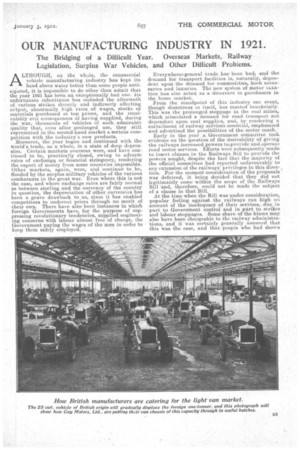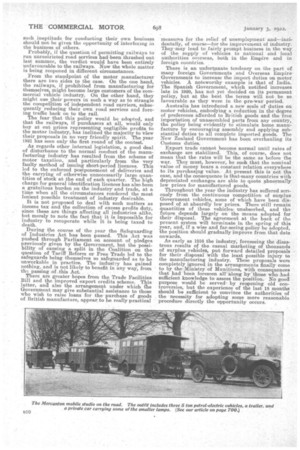OUR MANUFACTURING INDUSTRY IN 1921.
Page 9

Page 10

If you've noticed an error in this article please click here to report it so we can fix it.
The Bridging of a Difficult Year. Overseas Markets, Railway Legislation, Surplus War Vehicles, arid Other Difficult Problems.
ALTHOUGH, on the whale, the commercial vehicle manufacturing industry has kept its . head above water better than some people anti.• eipated, it is impossible to do other than admit that the year 1921 has been an exceptionally bad one. Its unfortunate inheritance has included the aftermath of vanous strikes directly and indirectly affecting output, abnormally high rates of wages, stocks of materials purchased at top prices, and the incalculably evil consequences of having supplied, during the war, thousands of vehicles of such. admirable quality that, even after prolonged use, they still represented in the second-hand market a serious competition with the industry's new products.
Moreover, the year began and continued with the world's trade, as a whole, in a state of deep depression. Certain markets overseas were, and have continued to be, practically closed, owing to adverse rates of exchange or financial stringency, rendering the export of money from some countries impossible. Other markets, again, were, and continue to be, flooded by the surplus military vehicles of the various combatants in the great war. Even where this is not the ease, and where exchange rates are fairly normal as between sterling and the currency of the country in question, the depreciation of other currencies has been a grave drawback to us, since it has enabled competitors to undercut prices through no merit of their own. There have also been instances in which foreign Governments have, for the purpose of suppressing revolutionary tendencies, supplied engineering concerns with labour almost free of charge, the Government paying the wages of the men in order to keep them safely employed. Everywhere4general trade has been bad, and the demand for transport facilities is, naturally, dependent upon the demand for commodities, oth necessaries and luxuries. The new system dmotor taxation has also acted as a deterrent to purchasers in the home market.
From the standpoint of this industry one event, though disastrous in itself, has reacted beneficially. This was the prolonged stoppage in the coal mines, which stimulated a demand for road, transport not dependent upon coal supplies, and, by rendering a curtailment of railway services essential, emphasized and advertised the possibilities of the motor coach.
Early in the year a. Government committee took evidence on the question of the desirability of giving the railways increased powers to,provide and operate road motor services. Efforts were subsequently made to insert clauses in the Railways Bill to provide the powers sought, despite the fact that the majority of the official committee had reported unfavourably to any extension of the railways' privileges in this diree-, tion. For the moment consideration of the proposals was deferred, it being decided that they did not legitimately conic within the scope of the Railways Bill -and, therefore, could not be made the .subjeet of a clause in that Bill.
At the time when the Bill was under consideration, popular feeling against 'the railways, ran high Oil account of the inadequacy of theit services, . due in part to Government control and in part to strikes and labour stoppages. Some share of the blame may also have been chargeable to the railway administrations, and it was certainly generally assumed that this was the case, and that 'people who had shown
such ineptitude for conducting their own business should not be given the opportunity of interfering in the business of others.
Probably, if the question -of permitting railways to run unrestricted road services had been thrashed out last summer, the verdict would have been entirely -unfavourable to the railways. Now the whole matter is being reopened in different circumstances.
From the standpoint of the motor manufacturer there are two sides to the case. On the one hand, the railways, if prohibited from manufacturing for themselves, might become large customers of the commercial vehicle industry. On the other hand, they might use their powers in such a way as to strangle the competition of independent road carriers, subsequently reducing their own road services and forcing traffic back on to the rail.
The fear that this policy would be adopted, and that the railways, if purchasers at all, would only buy at cut prices representing negligible profits to the motor industry, has inclined the majority to view their proposals in no very friendly spirit. The year 1921 has seen only the first round of the contest.
As regards other internal legislation, a good deal of disturbance to the normal conduct of the manufacturing industry has resulted from the scheme of motor taxation, and particularly from the very faulty method of issuing short-period licences. This led to the enforced postponement of deliveries and the carrying of otherwise unnecessarily large quantities of stock at _the end of each quarter. The high charge for general identification licences has also been a gratuitous burden on the industry and trade, at a time when all the circumstances rendered the most lenient possible treatment of industry desirable. It is not proposed to deal with such matters as income tax and• the collection of excess profits duty, since these are things affecting all industries alike, but merely to note the fact that it is impossible for industry to recuperate while it is being taxed to death.
During the course of the year the Safeguarding of Industries Act has been passed. This Act was pushed through Parliament on account of pledges previously given by the Government, but the possibility of causing a split in the Coalition on the question of Tariff Reform or Free Trade led to the safeguards being themselves so safeguarded as to be unworkable in practice. The industry has gained nothing, and is not likely to benefit in any way, from the passing of this Act. There are greater hopes from the Trade Facilities Bill and the improved export credits scheme. This latter, and also the arrangement under which the Government may give substantial assistance to those who wish to raise loans for the-purchase of goods of British manufacture, appear to be really practical measures for the relief of unemployment and—incidentally, of course—for the improvement of industry. They-may lead to fairly prompt business in the way of the supply of vehicles to national and local authorities overseas, both in the Empire and in foreign countries. •
There is an unfortunate tendency on the part of many foreign Governments and Overseas Empire• Governments to increase the import duties on motor vehicles. A noteworthy example is that of India. The Spanish Government, which notified increases late in 1920, has not yet decided on its permanent policy, but at the best the terms will not be so favourable as they were in the pre-war period.
Australia has introduced a new scale of duties on motor vehicles, embodying a reduction in the degree of preference afforded to British goods and the free importation of unassembled parts from any country, the policy being evidently to stimulate home manufacture by encouraging assembly and applying substantial duties to all complete imported goods. The New Zealand Government has been overhauling its Customs duties.
Export trade cannot become normal until rates of exchange are stabilized. This, of course, does not mean that the rates will be the same as before the war. They must, however, be such that the nominal value of money bears a constant relation everywhere to its purchasing value. • At present this is not the case, and the consequence is that-many countries with depreciated exchanges are able to quote abnormally low prices for manufactured goods.
Throughout the year the industry has suffered seriously from the continuous competition of surplus Government vehicles, some of which have been disposed of at absurdly low prices. There still remain quantities of these vehicles • unabsorbed, and the future depends largely on the means adopted for their disposal. The agreement at the back of the present system will terminate in the spring of this year, and, if a wise and far-seeing policy be adopted, the position should gradually improve from that date onwards.
As early as 1916 the industry, foreseeing the disastrous results of the casual marketing of thousands of surplus vehicles, put forward detailed proposals for their disposal with the least possible injury to the manufacturing industry. These proposals were completely ignored in the arrangements finally come to by the, Ministry of Munitions, with consequences that had been foreseen all along by those who had sufficient knowledge to assess the position. No good purpose would be served by reopening old controversies, but the experience of the last 18 months should be sufficient to convince the authorities of the necessity for adopting some more reasonable procedure directly the opportunity occurs.




























